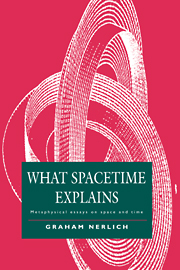Book contents
- Frontmatter
- Contents
- Preface
- Introduction
- Part One Ontology and methodology in relativity
- Part Two Variable curvature and General Relativity
- 6 How Euclidean geometry has misled metaphysics
- 7 What can geometry explain?
- 8 Is Curvature intrinsic to physical space?
- 9 Holes in the hole argument
- Part Three Time and causation
- Bibliography
- Index
8 - Is Curvature intrinsic to physical space?
Published online by Cambridge University Press: 19 October 2009
- Frontmatter
- Contents
- Preface
- Introduction
- Part One Ontology and methodology in relativity
- Part Two Variable curvature and General Relativity
- 6 How Euclidean geometry has misled metaphysics
- 7 What can geometry explain?
- 8 Is Curvature intrinsic to physical space?
- 9 Holes in the hole argument
- Part Three Time and causation
- Bibliography
- Index
Summary
Wesley C. Salmon (1977b) has written a characteristically elegant and ingenious paper ‘The Curvature of Physical Space’. He argues in it that the curvature of a space cannot be an intrinsic property of it. Salmon's view is that space, in respect of this and other affine structures, is amorphous. He relates this to Grünbaum's arguments (Grünbaum 1973, esp. chapters 16 and 22) that space is metrically amorphous and acknowledges parallels between the arguments which have been offered for each opinion. I wish to dispute these conclusions on philosophical grounds quite as much as on geometrical ones. Although I concentrate most on arguing for a well-defined, intrinsic affinity for physical space, the arguments extend easily to support a well-defined, intrinsic metric.
Coordination with real numbers
I assume that we are dealing with continuous suitably differentiable physical space unless the contrary is specified. It is worth remarking at the outset that I do not regard physical space as a set with points as its members but rather as a whole with points as its parts. It is possible to define continuity for space conceived of in this way (see Mortensen and Nerlich 1978). Physical (or part-whole) topology differs from set-theoretic topology (order type) in only minor ways: each set-interval contains a null subset but no physical interval contains a null part. I will largely gloss over these minor divergences however. Certainly, there is enough structure in physical topology to allow me to agree with Salmon on the following well-established matters. There exist countless one-to-one correspondences between the elements in any interval of the real number system and the points in any one-dimensional interval of space.
- Type
- Chapter
- Information
- What Spacetime ExplainsMetaphysical Essays on Space and Time, pp. 185 - 205Publisher: Cambridge University PressPrint publication year: 1994



